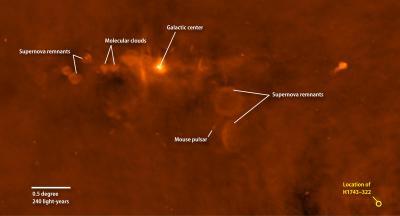Using observations from NASA's Rossi X-ray Timing Explorer (RXTE) satellite and the National Science Foundation's (NSF) Very Long Baseline Array (VLBA) radio telescope, an international team of astronomers has identified the moment when a black hole in our galaxy launched super-fast knots of gas into space.
Racing outward at about one-quarter the speed of light, these "bullets" of ionized gas are thought to arise from a region located just outside the black hole's event horizon, the point beyond which nothing can escape.
"Like a referee at a sports game, we essentially rewound the footage on the bullets' progress, pinpointing when they were launched," said Gregory Sivakoff of the University of Alberta in Canada. He presented the findings today at the American Astronomical Society meeting in Austin, Texas. "With the unique capabilities of RXTE and the VLBA, we can associate their ejection with changes that likely signaled the start of the process."
The research centered on the mid-2009 outburst of a binary system known as H1743, located about 28,000 light-years away toward the constellation Scorpius. Discovered by NASA's HEAO-1 satellite in 1977, the system is composed of a normal star and a black hole of modest but unknown masses. Their orbit around each other is measured in days, which puts them so close together that the black hole pulls a continuous stream of matter from its stellar companion. The flowing gas forms a flattened accretion disk millions of miles across, several times wider than our sun, centered on the black hole. As matter swirls inward, it is compressed and heated to tens of millions of degrees, so hot that it emits X-rays.
Some of the infalling matter becomes re-directed out of the accretion disk as dual, oppositely directed jets. Most of the time, the jets consist of a steady flow of particles. Occasionally, though, they morph into more powerful outflows that hurl massive gas blobs at significant fractions of the speed of light.
In early June 2009, H1743 underwent this transition as astronomers watched with RXTE, the VLBA, the Very Large Array near Socorro, N.M., and the Australia Telescope Compact Array (ATCA) near Narrabri in New South Wales. The observatories captured changes in the system's X-ray and radio emissions as the transformation occurred.

This 327-MHz radio view of the center of our galaxy highlights the position of the black hole system H1743-322, as well as other features.
(Photo Credit: : J. Miller-Jones, ICRAR-Curtin Univ.; C. Brogan, NRAO)
From May 28 to June 2, the system's X-ray and radio emissions were fairly steady, although RXTE data show that cyclic X-ray variations, known as quasi-periodic oscillations or QPOs, gradually increased in frequency over the same period. On June 4, ATCA measurements showed that the radio emission had faded significantly.
Astronomers interpret QPOs as signals produced by the interaction of clumps of ionized gas in the accretion disk near the black hole. When RXTE next looked at the system on June 5, the QPOs were gone.
The same day, the radio emission increased. An extremely detailed VLBA image revealed a bright, radio-emitting bullet of gas moving outward from the system in the direction of one of the jets. On June 6, a second blob, moving away in the opposite direction, was seen.
Until now, astronomers had associated the onset of the radio outburst with the bullet ejection event. However, based on the VLBA data, the team calculated that the bullets were launched on June 3, about two days before the main radio flare. A paper on the findings will be published in the Monthly Notices of the Royal Astronomical Society.
"This research provides new clues about the conditions needed to initiate a jet and can guide our thinking about how it happens," said Chris Done, an astrophysicist at the University of Durham, England, who was not involved in the study.
A super-sized version of the same phenomenon occurs at the center of an active galaxy, where a black hole weighing millions to billions of times our sun's mass can drive outflows extending millions of light-years.
"Black hole jets in binary star systems act as fast-forwarded versions of their galactic-scale cousins, giving us insights into how they work and how their enormous energy output can influence the growth of galaxies and clusters of galaxies," said lead researcher James Miller-Jones at the International Center for Radio Astronomy Research at Curtin University in Perth, Australia.
Source: NASA/Goddard Space Flight Center